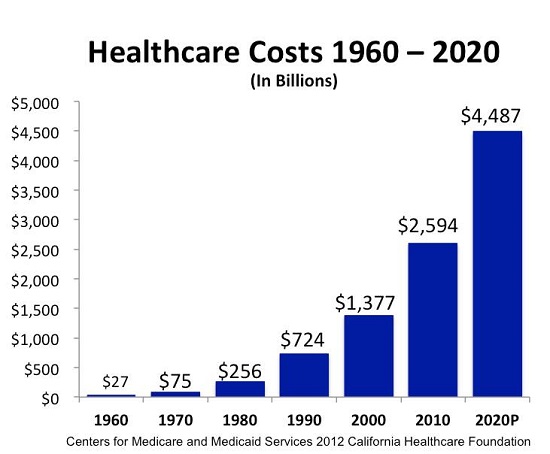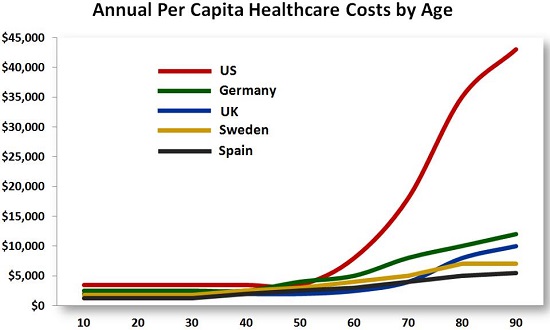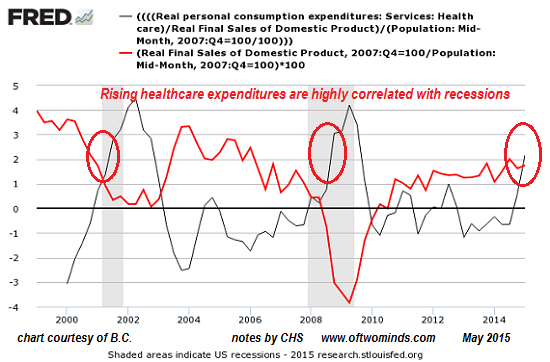How Healthcare Is Dooming the U.S. Economy
Three charts crystallize the healthcare dynamics that are dooming the U.S. economy. The first depicts the runaway growth of healthcare costs–a rapid expansion that is a permanent feature of U.S. healthcare, regardless of which party is in office or what reforms are instituted.
This expansion of costs has many drivers, most of which result from the system’s perverse incentives for fraud, overbilling, marginal treatments and defensive medicine.Technological and medical advances offer more options for treatment, and can push costs up–but advances can just as readily push costs down, too.
The primary drivers of rapidly increasing costs are:
1. The cartel/crony-capitalist structure of U.S. healthcare
2. Defensive medicine to stave off litigation
3. Profiteering from needless or ineffective tests, procedures and medications
4. Fraud and overbilling
5. The concentration of expenditures in a small sector of the population
6. America’s inability and/or unwillingness to have an adult discussion over end-of-life care for the elderly.
Here is a chart of the rising cost of U.S. healthcare, which is far outstripping the growth of GDP, which is another way of saying healthcare costs are outstripping our ability to pay for healthcare.

Other advanced nations pay for universal healthcare with 8%-9% of their GDP, where the U.S. spends 18% of GDP on less-than-universal healthcare. How do other advanced countries provide healthcare for all for less than half of what America spends per person (per capita)?
Other advanced nations do not spend gargantuan sums on the elderly and end-of-life care. Please look carefully at this chart. No one with any knowledge of life in Sweden or Germany would declare their care of the elderly barbarous, yet somehow Sweden’s cost of care actually declines as the elderly approach the end of their lives, while the cost of care for the elderly skyrockets in the U.S.
Is medical care that different technologically in the U.S. and Sweden, or is it the difference between a system that is rational and one that is based on extracting the maximum profit from delivering whatever the government will pay for?

Now that the 60+ million Baby Boom generation is entering Medicare, the soaring cost of caring for the elderly American-style is about to explode higher. Anyone who holds the magical-thinking hope that America’s stagnant economy and job market can support healthcare costs that consume 25+% of GDP should study this article and the chart below: The Concentration of Health Care Spending (via B.C.)
Tt is clear that per-person spending among the highest users is substantial and represents a natural starting point when thinking about how to curb health care spending. For instance, the average expenditure for each of the approximately 3 million people comprising the top 1 percent of spenders was more than $90,000 in 2009 (Figure 2). The top 5 percent of spenders were responsible for $623 billion in expenditures or nearly $41,000 per patient. In contrast, mean annual spending for the bottom half of distribution was just $236 per person, totaling only $36 billion for the entire group of more than 150 million people.
The concentration of healthcare expenditures in a thin slice of the populace is astonishing: 20% of the costs are spent on 1% of the populace, typically elderly people with multiple chronic lifestyle-related diseases. 50% of the total costs are spent on the top 5% of high-use individuals.
One direct result of rising healthcare expenditures is recession, as this chart from frequent contributor B.C. illustrates. As healthcare expenditures rise, real sales stagnate and the economy cascades into recession.

The majority of U.S. healthcare spending is not productive; it is a drag on productivity. Subtract the fraud, overbilling, defensive medicine, marginal/ineffective overtreatments and tests and the extreme concentration of costs in 5% of the populace, and we’d have a system that we could afford, i.e. one that cost less than 10% of GDP, in line with our advanced-economy competitors.
As it stands now, U.S. healthcare will bankrupt the nation and doom it to permanent stagnation and recession. It’s our choice: live with a bankrupt system built almost entirely of perverse incentives, or begin an adult discussion about a system that delivers responsible care to the elderly in line with other advanced nations, but at a fraction of the current cost.
How to forge a career in a recessionary economy:
Get a Job, Build a Real Career and Defy a Bewildering Economy,
a mere $9.95 for the Kindle ebook edition and $18 for the print edition.
Leave a Reply